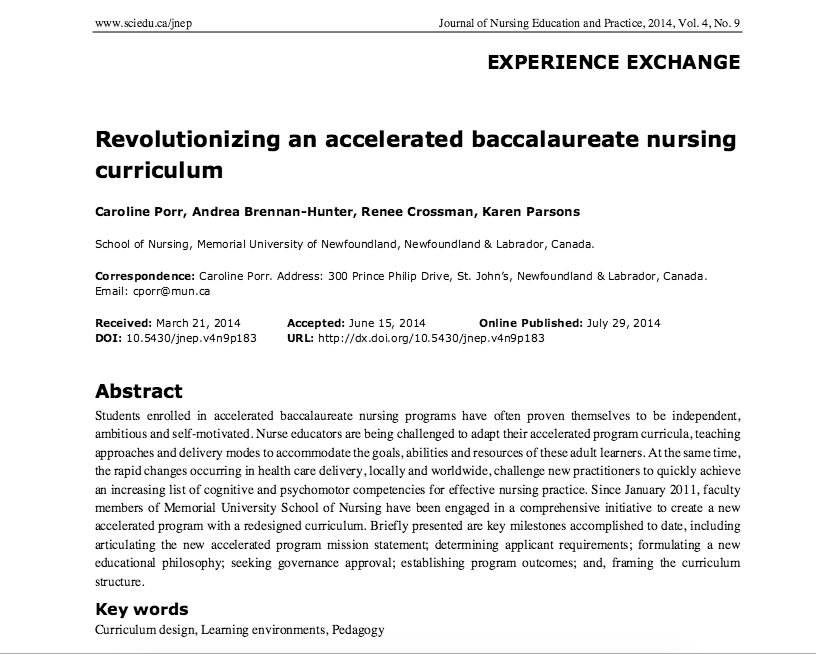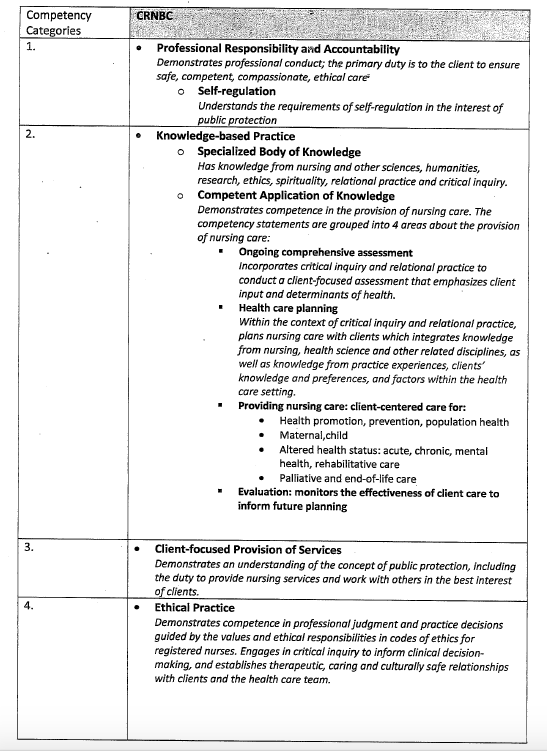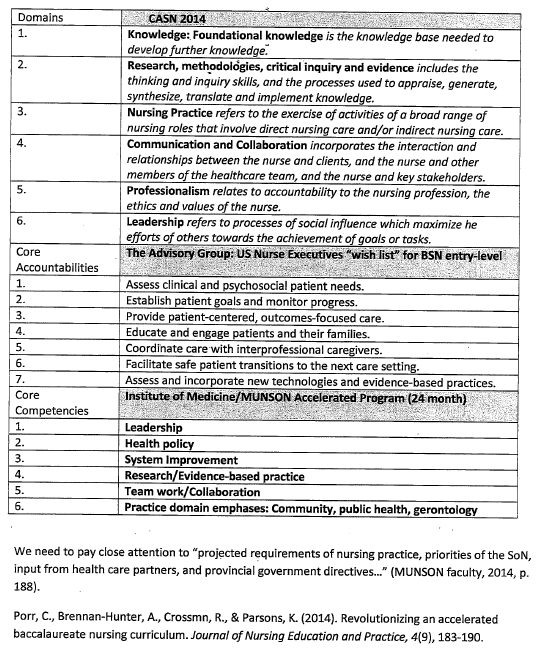Our brown bag journal article, “Revolutionizing an accelerated baccalaureate curriculum,” was used to compare and contrast trends across the country with respect to accelerated BSN programs. The article describes curriculum transformation for one accelerated BSN program, Memorial University School of Nursing (MUnSoN), in Newfoundland/Labrador. UBC School of Nursing (SoN) is beginning curriculum transformation— review and discussion of other nursing faculty experiences is very pertinent to us. According to the article authors, almost 50% of Canadian Schools of Nursing offer an accelerated BSN version—typically 24 months. UBC’s program is 20 months: currently the shortest BSN program in Canada (to our knowledge).
Accelerated programs are attracting students born in the 1980s-1990s who typically have at least one college degree, considerable life experience and emotional maturity. These types of students prefer flexible curriculum delivery and multi-media learning options; and they are technologically savvy.
At UBC SoN, we introduced a flexible curriculum delivery model in 2013. Similar to the MUnSoN curriculum delivery model, we combine online learning with in-class active learning strategies, skills lab simulations, and a variety of clinical learning experiences. To stay current with actual/projected population healthcare needs, our faculty are providing more community-based experiential learning activities for students, and adult/older adult care in a major focus of our theory/practice content. We are fortunate to have several faculty with community health/public health experience and expertise in senior care.
In 2013, our SoN received internal educational grant funding to “blend” our undergraduate courses. Over a 2-year period, we converted 10% of in-class content to online—freeing up class “seat” time for students to participate in other learning opportunities. An example of new learning opportunities is interprofessional education (IPE) events where health disciplines students discuss patient cases and problem solve together (e.g., simulated teams). Our blended content includes commercial products, such as The Canadian Neighbourhood online vignettes of individuals and families and their intersections with healthcare providers in acute care and community care settings. Blended content also includes online modules that our faculty have developed and customized. We recently completed an online health policy module that will be foundational content for four of our undergraduate courses.
Although we have made progress with our flexible curriculum delivery model, a great deal of work remains. Schools of Nursing need to consider faculty release time to design, implement and evaluate new modes of curriculum delivery—and to ensure conceptual linkages across these different modes of delivery within and across courses. We know, for instance, that we have some great blended learning options in our courses, but we are not sure how well they connect with each other. We also know that students learn better when there are explicit conceptual linkages within and across courses—to help them more effectively, efficiently consolidate their learning. As a faculty, therefore, we need to take time to create seamless curriculum delivery of core concepts.
When MUnSoN went through its curriculum transformation, faculty planned their new curriculum around a vision of the nurse of the future: What types of nurses will we need to provide quality, safe care 5-to-10 years from now? To assist faculty visioning, there are a number of documents that propose what the future nurse will be like—and what types of competencies they will need to possess. MUnSoN faculty used the Institute of Medicine (IOM) Future of Nursing document and their regulatory body’s current entry-level requirements to craft a new curriculum with the following core concepts: leadership, health policy, systems improvement, research, evidence-based policy, teamwork, collaboration. Attached is a document I’ve put together with core concepts in futurist documents from the IOM and a ‘wish list’ from US Nurse Executives; and competency documents from the Canadian Association of Schools of Nursing and BC’s regulatory body, the College of Registered Nurses of BC. What is striking, to me, is that they are all similar, and I don’t see a lot of difference between our current core concepts and futurist concepts. I don’t see a lot of innovation or “outside the box” thinking when it comes to the future of nursing in North America. In BC, it seems that we’re going backwards. Health authorities are hiring on more and more practical nurses, and NPs are being under-utilized.
In our brown bag, we also compared/contrasted pre-requisites for accelerated BSN programs. MUnSoN, for instance, requires a Bachelor’s degree from another discipline, a GPA of at least 3.0 and Statistics, Biochemistry, Microbiology, Anatomy & Physiology. Our current UBC pre-requisites are not as rigorous as MUnSoN’s. In a recent conversation with a colleague from another SoN, we talked about pre-requisites. Her SoN requires Statistics and Microbiology. Statistics is seen as preparation for graduate work. In her words, “the hope is that BSN students will go on to graduate and doctoral-level work. Statistics primes them for it.” She explained that at their SoN, Microbiology seems to be important preparation for Pharmacology: “Our students do better in Pharm with Micro as a pre-requisite.” To establish rationale for their pre-requisites, her university did some careful groundwork and evaluation of their students’ theory/practice performance . An underlying message for me, is that Schools of Nursing need to carefully consider what pre-requisites will enhance student success-particularly in more challenging accelerated programs.
In our next brown bag, we will look at the nursing movement to “return to basics.” To whet your curiosity, check out “Reclaimining and Redefining the Fundamentals of Care” (2013) by Alison Kitson and colleagues at: https://digital.library.adelaide.edu.au/dspace/bitstream/2440/75843/1/hdl_75843.pdf.



